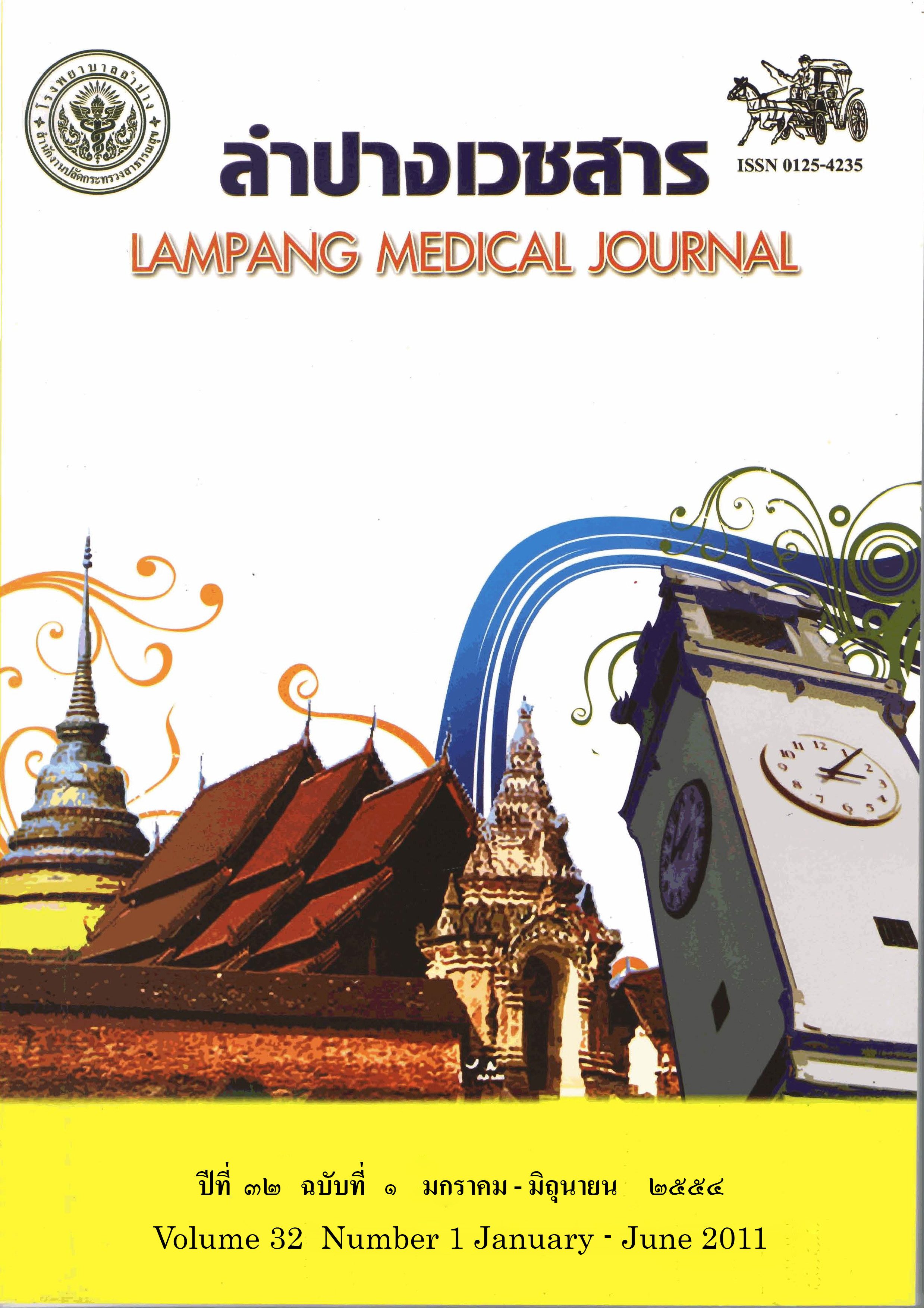Prevalence of Metabolic Syndrome among Health Care Personnel and Office Workers in Lampang Hospital
Main Article Content
Abstract
Background : Metabolic syndrome (MetS) increases higher risk of cardiovascular disease. Currently the most popular criteria for MetS diagnosis is the International Diabetes Federation (IDF) consensus 2005. Its prevalence has been documented in some studies in Thailand, but mostly did not use IDF criteria.
Objective : To estimate the prevalence of MetS in healthcare personnel and office workers in Lampang Hospital.
Material and method : The medical records of annual check-up results of Lampang Hospital personnel between October 2008 and September 2009 were retrospectively reviewed. General data, clinical findings and laboratory results were recorded. MetS diagnosis was based on IDF criteria. The data was analyzed by descriptive statistics.
Results : Among 1,199 personnel recruited in this study, the mean age was 46.2 ± 6.4 years and 83.1% were female. The prevalence of MetS was 9.5 % (15.3% in male and 8.3% in female). Its prevalence increased with age.
Conclusion : The prevalence of MetS in healthcare personnel and office workers in Lampang Hospital was 9.5% and increased with age. Diet control and regular exercise should be encouraged to decrease the risk of cardiovascular disease.
Article Details

This work is licensed under a Creative Commons Attribution-NonCommercial-NoDerivatives 4.0 International License.
บทความที่ส่งมาลงพิมพ์ต้องไม่เคยพิมพ์หรือกำลังได้รับการพิจารณาตีพิมพ์ในวารสารอื่น เนื้อหาในบทความต้องเป็นผลงานของผู้นิพนธ์เอง ไม่ได้ลอกเลียนหรือตัดทอนจากบทความอื่น โดยไม่ได้รับอนุญาตหรือไม่ได้อ้างอิงอย่างเหมาะสม การแก้ไขหรือให้ข้อมูลเพิ่มเติมแก่กองบรรณาธิการ จะต้องเสร็จสิ้นเป็นที่เรียบร้อยก่อนจะได้รับพิจารณาตีพิมพ์ และบทความที่ตีพิมพ์แล้วเป็นสมบัติ ของลำปางเวชสาร
References
Haffner SM, Valdez RA, Hazuda HP, Mitchell BD, Morales PA, Stern MP. Prospective analysis of the insulin-resistance syndrome (syndrome X). Diabetes 1992; 41(6): 715-22.
Isomaa B, Almergren T, Toumi T, Forsen B, Lahti K, Nisen M, et al. Cardiovascular morbidity and mortality associated with the metabolic syndrome. Diabetes Care 2001; 24: 683-9.
Malik S, Wong ND, Franklin SS, Kamath TV, I’Italien GJ, Pio JR, et al. Impact of the metabolic syndrome on mortality from coronary heart disease, cardiovascular disease and all causes in United States adults. Circulation 2004; 110: 1245-50.
Alberti KG, Zimmet P, Shaw J, IDF Epidemiology Task Force Consensus Group. The metabolic syndrome- a new worldwide definition. Lancet 2005; 366: 1059-62.
Lee WY, Park JS, Noh SY, Rhee EJ, Kim SW, Zimmet PZ. Prevalence of metabolic syndrome among 40,698 Korean metropolitan subjects. Diabetes Res Clin Pract 2004; 65: 143-9.
Chan JC, Cheung JC, Lau EM, Wooa J, Chan AY, Swaminathan R, et al. The metabolic syndrome in Hong Kong Chinese: the interrelationship among its component analyzed by structural equation modeling. Diabetes Care 1996; 19: 953-9.
Misra A, Vitkram NK. Insulin resistant syndrome (metabolic syndrome) and obesity in Asian Indians: evidence and implication. Nutrition 1994; 20: 482-91.
Gupta R, Deed wania PC, Gupta A, Rastogi S, Panwar RB, Kothari K. Prevalence of metabolic syndrome in an Indian urban population. Int J Cardiol 2004; 97: 257-61.
Pongchaiyakul C, Nguyen TV, Wanothayaroj E, Karusan N, Klungboonkrong V. Prevalence of metabolic syndrome and its relationship to weight in the Thai population. J Med Assoc Thai 2007; 90(3): 459-67.
Santibhavank P. Prevalence of metabolic syndrome in Nakhon Sawan population. J Med Assoc Thai 2007; 90(6): 1109-15.
Lohsoonthorn V, Lertmaharit S, Williams M. Prevalence of metabolic syndrome among professional and office workers in Bangkok, Thailand. J Med Assoc Thai 2007; 90(9): 1908-15.
Tan CE, Ma S, Wai D, Chew SK, Tai ES. Can we apply the National Cholestrol Education Program Adult Treatment Panel definition of the metabolic syndrome to Asians?. Diabetes Care 2004; 27(5): 1182-6.
Ford ES, Giles WH. Prevalence of metabolic syndrome among US adult: finding from the third national health and nutrition examination survey. JAMA 2002; 287: 356-9.
Cheung BM, Wat NM, Man YB, Tam S, Cheng CH, Leung GM, et al. Relationship between the metabolic syndrome and the development of hypertension in the Hong Kong Cardiovascular Risk Factor Prevalence Study-2 (CRISPS2). Am J Hypertens 2008; 21: 17-22.
Pinitphol S, Bunnag P. Metabolic syndrome in type 2 diabetic patients at Chainat Hospital. Intern Med J Thai 2005; 21: 195-202.


